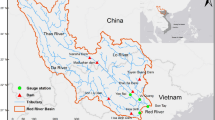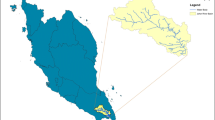Abstract
Estimating total sediment discharge is challenging. This study aims to assess performances of various data-driven models including empirical equations, machine learning (ML), and ensemble models for such estimations. The ML models include Support Vector Machine (SVM), Artificial Neural Network (ANN), K Nearest Neighbor (KNN), Random Forest (RF), and Decision Tree Regression (DTR). For this purpose, 543 widely-ranged data were collected from the United States Geological Survey (USGS) resources and used to train and test different models. Ranking different models demonstrated that Ackers and White's equation outperformed multiple linear regression (MLR) and SVM, which indicates that all ML models do not necessarily outperform empirical equations. Moreover, despite conducting multiple runs and parameter tuning, the results consistently indicated that increasing the number of hidden layers and neurons in ANN structures did not significantly improve the overall performance of the ANN models. In addition, the nonlinear ensemble model outperformed all methods and placed first in the ranking. Despite a notable difference between metrics obtained by KNN for the train and test data, it outperformed other methods and ranked second, while ANN achieved the third-best ranking place. The obtained result was also confirmed by the reliability analysis and confidence limits. However, due to negative predictions for some small sediment discharges by the nonlinear ensemble method, it did not demonstrate good reliability. Finally, the comparative analysis indicates that selecting a suitable model for estimating sediment discharges with a desirable accuracy is challenging, while further studies are required to assess other ML models or variants of ensemble models.







Similar content being viewed by others
Data availability
Data is freely available from (Williams and Rosgen 1989).
References
Afan HA, El-shafie A, Mohtar WHMW, Yaseen ZM (2016) Past, present and prospect of an Artificial Intelligence (AI) based model for sediment transport prediction. J Hydrol 541:902–913
Azamathulla HM, Ghani AA, Chang CK, Hasan ZA, Zakaria NA (2010) Machine learning approach to predict sediment load–a case study. CLEAN - Soil Air Water 38:969–976
Banadkooki FB, Ehteram M, Ahmed AN, Teo FY, Ebrahimi M, Fai CM, Huang YF, El-Shafie A (2020) Suspended sediment load prediction using artificial neural network and ant lion optimization algorithm. Environ Sci Pollut Res 27:38094–38116
Bhattacharya B, Price RK, Solomatine DP (2007) Machine learning approach to modeling sediment transport. J Hydraul Eng 133:440–450
Bisong E (2019) Building machine learning and deep learning models on Google cloud platform. Apress, Berkeley, pp 59–64
Choubin B, Darabi H, Rahmati O, Sajedi-Hosseini F, Kløve B (2018) River suspended sediment modelling using the CART model: a comparative study of machine learning techniques. Sci Total Environ 615:272–281
Doğan E, Yüksel İ, Kişi Ö (2007) Estimation of total sediment load concentration obtained by experimental study using artificial neural networks. Environ Fluid Mech 7:271–288
Fathabadi A, Seyedian SM, Malekian A (2022) Comparison of Bayesian, k-Nearest Neighbor and Gaussian process regression methods for quantifying uncertainty of suspended sediment concentration prediction. Sci Total Environ 818:151760
Garcia M (2008) Sedimentation engineering: processes, measurements, modeling, and practice. American Society of Civil Engineers, Reston
Harun MA, Safari MJS, Gul E, Ghani AA (2021) Regression models for sediment transport in tropical rivers. Environ Sci Pollut Res 28:53097–53115
Jahromi ME, Afzali SH (2014) Application of the HBMO approach to predict the total sediment discharge. Iran J Sci Technol - Trans Civ Eng 38:123
Kargar K, Safari MJS, Khosravi K (2021) Weighted instances handler wrapper and rotation forest-based hybrid algorithms for sediment transport modeling. J Hydrol 598:126452
Ketkar N, Ketkar N (2017) Introduction to keras. Deep learning with python: a hands-on introduction. Springer, pp 97–111
Kitsikoudis V, Sidiropoulos E, Hrissanthou V (2015) Assessment of sediment transport approaches for sand-bed rivers by means of machine learning. Hydrol Sci J 60:1566–1586
Kumar A, Kumar P, Singh VK (2019) Evaluating different machine learning models for runoff and suspended sediment simulation. Water Resour Manag 33:1217–1231
Latif SD, Chong KL, Ahmed AN, Huang YF, Sherif M, El-Shafie A (2023) Sediment load prediction in Johor river: deep learning versus machine learning models. Appl Water Sci 13:79
Leong WC, Bahadori A, Zhang J, Ahmad Z (2021) Prediction of water quality index (WQI) using support vector machine (SVM) and least square-support vector machine (LS-SVM). Int J River Basin Manag 19:149–156
Loh WY (2011) Classification and regression trees. Wiley interdisciplinary reviews: data mining and knowledge discovery, vol 1, no. 1, pp 14–23
Maulud D, Abdulazeez AM (2020) A review on linear regression comprehensive in machine learning. J Appl Sci Technol Trends 1:140–147
Müller AC, Guido S (2016) Introduction to machine learning with Python: a guide for data scientists. O'Reilly Media, Inc.
Nagy HM, Watanabe KAND, Hirano M (2002) Prediction of sediment load concentration in rivers using artificial neural network model. J Hydraul Eng 128:588–595
Naqshband S, Ribberink JS, Hurther D, Hulscher SJMH (2014) Bed load and suspended load contributions to migrating sand dunes in equilibrium. J Geophys Res Earth Surf 119:1043–1063
Niazkar M (2020) Assessment of artificial intelligence models for calculating optimum properties of lined channels. J Hydroinf 22:1410–1423
Niazkar M (2022) Appraisal of multigene genetic programming for estimating optimal properties of lined open channels with circular shapes incorporating constant and variable roughness scenarios. In: Current Directions in Water Scarcity Research. Elsevier, vol 7, pp 285–297. https://doi.org/10.1016/B978-0-323-91910-4.00017-0
Niazkar M, Zakwan M (2021) Application of MGGP, ANN, MHBMO, GRG, and linear regression for develo** daily sediment rating curves. Math Probl Eng 2021:1–13. https://doi.org/10.1155/2021/8574063
Niazkar M, Zakwan M (2023) Develo** ensemble models for estimating sediment loads for different times scales. Environ Dev Sustain:1–19
Nugrahaeni RA, Mutijarsa K (2016) Comparative analysis of machine learning KNN, SVM, and random forests algorithm for facial expression classification. In: 2016 International Seminar on Application for Technology of Information and Communication (ISemantic). IEEE, pp 163–168
Pedregosa F, Varoquaux G, Gramfort A, Michel V, Thirion B, Grisel O, Blondel M, Prettenhofer P, Weiss R, Dubourg V (2011) Scikit-learn: machine learning in python. J Mach Learn Res 12:2825–30
Piraei R, Niazkar M, Afzali SH, Menapace A (2023) Application of machine learning models to bridge afflux estimation. Water 15:2187
Recking A (2013) Simple method for calculating reach-averaged bed-load transport. J Hydraul Eng 139:70–75
Salih SQ, Sharafati A, Khosravi K, Faris H, Kisi O, Tao H, Ali M, Yaseen ZM (2020) River suspended sediment load prediction based on river discharge information: application of newly developed data mining models. Hydrol Sci J 65:624–637
Samadianfard S, Kargar K, Shadkani S, Hashemi S, Abbaspour A, Safari MJS (2022) Hybrid models for suspended sediment prediction: optimized random forest and multi-layer perceptron through genetic algorithm and stochastic gradient descent methods. Neural Comput Appl 34:3033–3051
Sharafati A, Haghbin M, Motta D, Yaseen ZM (2021) The application of soft computing models and empirical formulations for hydraulic structure scouring depth simulation: a comprehensive review, assessment and possible future research direction. Arch Comput Methods Eng 28:423–447
Sharghi E, Nourani V, Najafi H, Gokcekus H (2019) Conjunction of a newly proposed emotional ANN (EANN) and wavelet transform for suspended sediment load modeling. Water Supply 19:1726–1734
Simeone O (2018) A brief introduction to machine learning for engineers. Found Trends Signal Process 12:200–431
Sulaiman SO, Al-Ansari N, Shahadha A, Ismaeel R, Mohammad S (2021) Evaluation of sediment transport empirical equations: case study of the Euphrates River West Iraq. Arab J Geosci 14:1–11
Williams GP, Rosgen DL (1989) Measured total sediment loads (suspended loads and bedloads) for 93 United States streams. US Geological Survey, Washington, DC
Yadav A, Satyannarayana P (2020) ’Multi-objective genetic algorithm optimization of artificial neural network for estimating suspended sediment yield in Mahanadi River basin, India. Int J River Basin Manag 18:207–215
Yang CT (2003) Sediment transport: theory and practice. Krieger Pub., Malabar
Yang CT, Marsooli R, Aalami MT (2009) Evaluation of total load sediment transport formulas using ANN. Int J Sedim Res 24:274–286
Acknowledgements
The authors express their sincere appreciation to Mr. Ali Mahmoodi, who provided authors with useful comments during conducting the current study.
Author information
Authors and Affiliations
Contributions
Reza Piraei, Majid Niazkar and Seied Hosein Afzali contributed to the study conception, design, material preparation, data collection and analysis. Supervision was done by Seied Hosein Afzali. The first draft of the manuscript was written by Reza Piraei and Majid Niazkar, and all authors commented on previous versions of the manuscript. All authors read and approved the final manuscript.
Corresponding author
Ethics declarations
Competing interests
The authors declare no competing interests.
Additional information
Communicated by: H. Babaie
Publisher's note
Springer Nature remains neutral with regard to jurisdictional claims in published maps and institutional affiliations.
Rights and permissions
Springer Nature or its licensor (e.g. a society or other partner) holds exclusive rights to this article under a publishing agreement with the author(s) or other rightsholder(s); author self-archiving of the accepted manuscript version of this article is solely governed by the terms of such publishing agreement and applicable law.
About this article
Cite this article
Piraei, R., Niazkar, M. & Afzali, S.H. Assessment of data-driven models for estimating total sediment discharge. Earth Sci Inform 16, 2795–2812 (2023). https://doi.org/10.1007/s12145-023-01069-6
Received:
Accepted:
Published:
Issue Date:
DOI: https://doi.org/10.1007/s12145-023-01069-6




